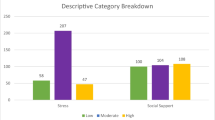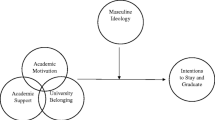Abstract
The purpose of this study is to determine if there are gender differences in the perception of university support. The study is based on a survey of 368 students in a Hong Kong university. The findings of the study are threefold. First, female students perceive the university as being more supportive in their academic adjustment than do male students (t = −4.256, p < 0.001). Second, male students perceive the university as being more supportive in their social adjustment than do female students (t = 2.156, p < 0.05). Last, male students perceive the university as being more supportive in their psychological adjustment than do female students (t= 2.401, p < 0.05).
Similar content being viewed by others
References
Askham, P. (2008). Context and identity: Exploring adult learners’ experiences of higher education. Journal of Further and Higher Education, 32(1), 85–97.
Becker, R., & Hecken, A. E. (2009). Higher education or vocational training? An empirical test of the rational action model of educational choices suggested by Breen and Goldthorpe and Esser. Acta Sociologica, 52(1), 25–45.
Castagnetti, C., & Rosti, L. (2009). Effort allocation in tournaments: The effect of gender on academic performance in Italian universities. Economics of Education Review, 28(3), 357–369.
Chow, H. P. H. (2010). Predicting academic success and psychological wellness in a sample of Canadian undergraduate students. Electronic Journal of Research in Educational Psychology, 8(2), 473–496.
Churchill, G. A. (1979). A paradigm for developing better measures of marketing constructs. Journal of Marketing Research, 16(1), 64–72.
Cliff, N. (1988). The eigenvalues-greater-than-one rule and the reliability of components. Psychological Bulletin, 103(2), 276–279.
Comrey, A. L. (1973). A first course in factor analysis. New York, NY: Academic Press.
Cook, S. L. (1995). Acceptance and expectation of sexual aggression in college students. Psychology of Women Quarterly, 19(2), 181–194.
Dayioglu, M., & Türüt-Asik, S. (2007). Gender differences in academic performance in a large public university in Turkey. Higher Education, 53(2), 255–277.
Downing, K., Chan, S. W., Downing, W. K., Kwong, T., & Lam, T. F. (2008). Measuring gender differences in cognitive functioning. Multicultural Education & Technology Journal, 2(1), 4–8.
Haggis, T. (2006). Pedagogies for diversity: Retaining critical challenge amidst fears of “dumbing down”. Studies in Higher Education, 31(5), 521–535.
Houston, M., Knox, H., & Rimmer, R. (2007). Wider access and progression among full-time students. Higher Education, 53(1), 107–146.
Hultberg, J., Plos, K., Hendry, G. D., & Kjellgren, K. I. (2008). Scaffolding students’ transition to higher education: Parallel introductory courses for students and teachers. Journal of Further and Higher Education, 32(1), 47–57.
Hyde, J. S., Fennema, E., & Lamon, S. J. (1990). Gender differences in mathematics performance: A meta-analysis. Psychological Bulletin, 107(2), 139–155.
Kaiser, H. F. (1960). The application of electronic computers to factor analysis. Educational and Psychological Measurement, 20(1), 141–151.
Kaiser, H. F., & Coffrey, J. (1965). Alpha factor analysis. Psychometrika, 30(1), 1–14.
Kenny, M. E., & Rice, K. G. (1995). Attachment to parents and adjustment in late adolescent college students: Current status, applications, and future considerations. Counseling Psychologist, 23(3), 433–456.
Lawrence, J. (2005, July 3–6). Addressing diversity in higher education: Two models for facilitating student engagement and mastery. Paper presented at Higher Education and Research Development Society of Australia Conference, Sydney. Retrieved from https://doi.org/www.conference.herdsa.org. au/2005/pdf/refereed/paper_300.pdf
Lawrence, J., Ashford, K., & Dent, P. (2006). Gender differences in coping strategies of undergraduate students and their impact on self-esteem and attainment. Active Learning in Higher Education, 7(3), 272–281.
Leese, M. (2010). Bridging the gap: Supporting student transitions into higher education. Journal of Further and Higher Education, 34(2), 239–251.
Li, C., & Ford, E. S. (2007). Is there a single underlying factor for the metabolic syndrome in adolescents? Diabetes Care, 30(6), 1556–1561.
Martin, W. E. Jr., Swartz, J. L., & Madson, M. (1999). Psychosocial factors that predict the college adjustment of first-year undergraduate students: Implications for college counselors. Journal of College Counseling, 2(2), 121–133.
McDermeit, M., Funk, R., Foss, M., & Dennis, M. (2000). Exploratory Factor Analysis with alpha method and varimax rotation. LI Analysis Training Series. Retrieved from https://doi.org/www.chestnut.org/LI/downloads/training_memos/factor_analysis.pdf
McNabb, R., Pal, S., & Sloane, P. (2002). Gender differences in educational attainment: The case of university students in England and Wales. Economica, 69(275), 481–503.
McWhirter, B. T. (1997). Loneliness, learned resourcefulness, and self-esteem in college students. Journal of Counseling and Development, 75(6), 460–469.
Nunnally, J. (1978). Psychometric theory. New York, NY: McGraw-Hill.
Pomerantz, E. M., Altermatt, E. R., & Saxon, J. L. (2002). Making the grade but feeling distressed: Gender differences in academic performance and internal distress. Journal of Educational Psychology, 94(2), 396–404.
Reay, D. (2002). Class, authenticity and the transition to higher education for mature students. Sociological Review, 50(3), 398–418.
Reay, D., Davies, J., David, M., & Ball, S. J. (2002). It’s taking me a long time but I’ll get there in the end: Mature students on access courses and higher education choice. British Educational Research Journal, 28(1), 5–19.
Richardson, J., & Woodley, A. (2003). Another look at the role of age, gender and subject as predictors of academic attainment in higher education. Studies in Higher Education, 28(4), 475–490.
Sheard, M. (2009). Hardiness commitment, gender, and age differentiate university academic performance. British Journal of Educational Psychology, 79(1), 189–204.
Smith, R. (2007). An overview of research on student support: Helping students to achieve or achieving institutional targets? Nurture or de-nature? Teaching in Higher Education, 12(5–6), 683–695.
The Women’s Foundation. (2006). The status of women and girls in Hong Kong 2006. Hong Kong: The Women’s Foundation and The Fund for Women in Asia.
Tremblay, P. F., Harris, R., Berman, H., MacQuarrie, B., Hutchinson, G. E., Smith, M. A., et al. (2008). Negative social experiences of university and college students. Canadian Journal of Higher Education, 38(3), 57–75.
University Grant Council. (2010). The statistical information of undergraduate student enrolment by gender. Hong Kong: University Grant Council. https://doi.org/www.cdcf.ugc.edu.hk/cdcf/searchStatisticRe-port.do
Wingate, U. (2007). A framework for transition: Supporting “learning to learn” in higher education. Higher Education Quarterly, 61(3), 391–406.
Wintre, M. G., Gates, S. K. E., Pancer, W. M., Pratt, M. S., Polivy, J., Birnie-Lefcovitch, S., et al. (2009). The Student Perception of University Support and Structure Scale: Development and validation. Journal of Youth Studies, 12(3), 289–306.
Yorke, M., & Longden, B. (2007). The first year experience in higher education: Report of Phase 1 of a project funded by the Higher Education Academy. York: Higher Education Academy.
Zwick, W. R., & Velicer, W. F. (1986). Comparison of five rules for determining the number of components to retain. Psychological Bulletin, 99(3), 432–442.
Author information
Authors and Affiliations
Corresponding author
Rights and permissions
About this article
Cite this article
Yau, H.K., Cheng, A.L.F. Are There Any Gender Differences in the Perception of University Support During the Transition Period to Higher Education?. Tert Educ Manag 18, 309–320 (2012). https://doi.org/10.1080/13583883.2012.697914
Received:
Accepted:
Published:
Issue Date:
DOI: https://doi.org/10.1080/13583883.2012.697914




